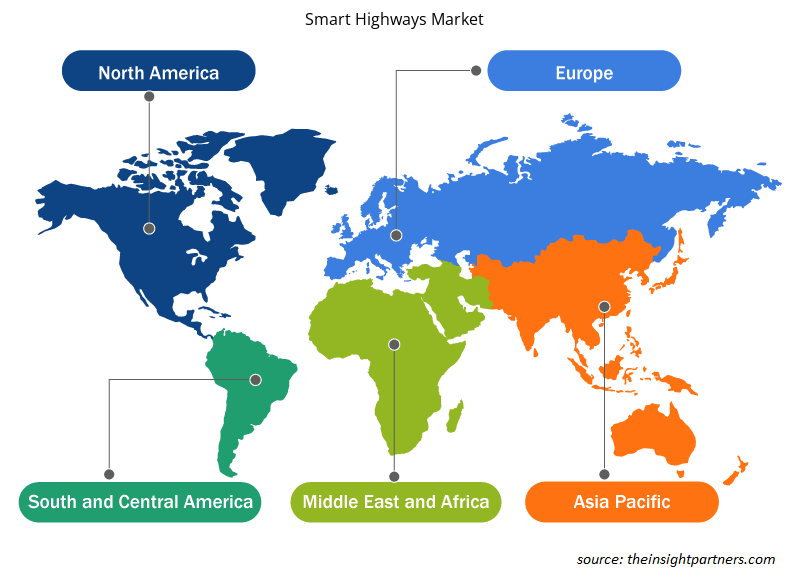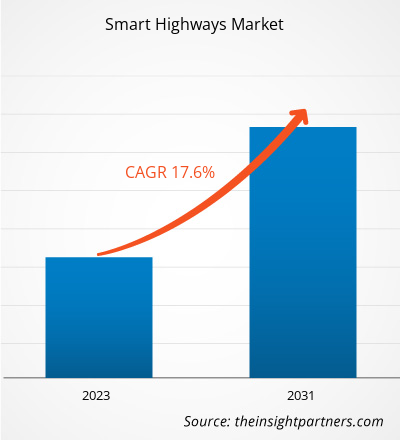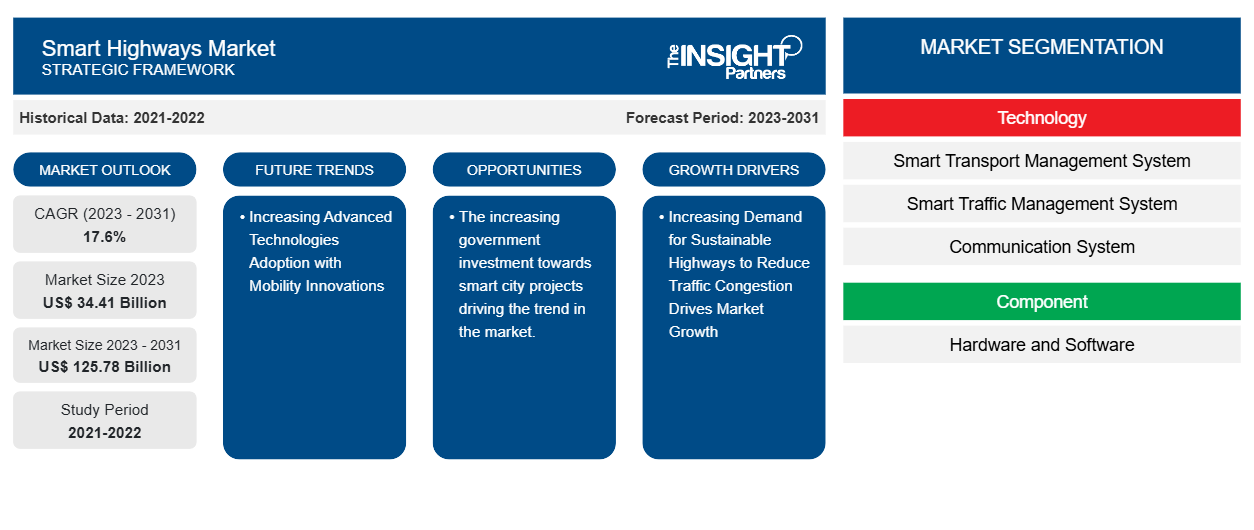Si prevede che la dimensione del mercato delle autostrade intelligenti raggiungerà i 125,78 miliardi di dollari entro il 2031, rispetto ai 34,41 miliardi di dollari del 2023. Si prevede che il mercato registrerà un CAGR del 17,6% nel periodo 2023-2031. Le crescenti iniziative governative per lo sviluppo di città intelligenti guidano la crescita del mercato. La crescente adozione di tecnologie avanzate per l'istituzione di città intelligenti in tutto il mondo è una tendenza trainante nel mercato.
Analisi di mercato delle autostrade intelligenti
L'aumento dello sviluppo di autostrade intelligenti con l'integrazione di tecnologie avanzate, come intelligenza artificiale, Internet of Things e dispositivi connessi, nelle strade di trasporto guida la crescita del mercato delle autostrade intelligenti. Ci sono vari enti governativi che pianificano di modificare i loro percorsi, in particolare le autostrade per supportare i sistemi di trasporto intelligenti e le infrastrutture stradali in tutto il mondo. Ad esempio, in Europa, Cooperative Intelligent Transport Systems ha costruito strade intelligenti che consentono agli utenti della strada e ai gestori del traffico di coordinare e condividere informazioni utili sulle attività stradali.
Panoramica del mercato delle autostrade intelligenti
L'adozione crescente e lo sviluppo di progetti di " città intelligente " nelle aree urbane con l'integrazione di una vasta rete di sensori per promuovere una migliore connettività guidano la crescita del mercato. Le città intelligenti in tutto il mondo stanno subendo cambiamenti significativi per rendere la vita dei cittadini migliore, più efficiente ed ecologica. Si prevede che innovazioni come la costruzione di città intelligenti rafforzeranno significativamente il mercato delle autostrade intelligenti negli anni a venire.
Grazie a progetti provenienti sia dal settore pubblico che da quello privato, la città di New York sta attualmente attraversando una trasformazione digitale grazie alle tecnologie all'avanguardia offerte dall'Internet of Things e dai dispositivi connessi.
Personalizza questo report in base alle tue esigenze
Riceverai la personalizzazione gratuita di qualsiasi report, comprese parti di questo report, o analisi a livello nazionale, pacchetto dati Excel, oltre a usufruire di grandi offerte e sconti per start-up e università
-
Scopri le principali tendenze di mercato in questo rapporto.Questo campione GRATUITO includerà analisi di dati che spaziano dalle tendenze di mercato alle stime e alle previsioni.
Driver e opportunità del mercato delle autostrade intelligenti
La crescente domanda di autostrade sostenibili per ridurre la congestione del traffico stimola la crescita del mercato
Un'autostrada sostenibile consente lo sviluppo sociale e la crescita economica e riduce gli impatti negativi sull'ambiente. Secondo la Federal Highway Administration (FHWA), le autostrade sostenibili sono parte integrante dello sviluppo sostenibile che dovrebbe essere valutato e preso in considerazione per l'implementazione durante tutto il suo ciclo di vita, dalla progettazione alla costruzione, alle operazioni e alla manutenzione. Oltre ad affrontare le esigenze ambientali e delle risorse naturali, un'autostrada sostenibile soddisfa la domanda di accessibilità dei servizi di trasporto e percorsi sicuri e confortevoli per camminare, andare in bicicletta e raggiungere i mezzi pubblici. Le autorità autostradali negli Stati Uniti stanno affrontando la sostenibilità attraverso un'ampia gamma di iniziative, come sistemi di trasporto intelligenti (ITS), riciclaggio, pianificazione, collegamenti ambientali e requisiti del National Environmental Policy Act (NEPA).
L'aumento della spesa pubblica per l'edilizia e le infrastrutture stradali offrirà maggiori opportunità per il mercato delle Smart Highway del Nord America. La spesa pubblica per l'edilizia nei progetti di autostrade e strade negli Stati Uniti ha raggiunto i 95,5 miliardi di dollari nel 2021, secondo il Dipartimento dei trasporti degli Stati Uniti. Inoltre, secondo il Dipartimento dei trasporti degli Stati Uniti, circa 350 milioni di dollari sono stati investiti in fondi pubblici e privati per gli sviluppi delle smart city.
Aumentare l'adozione di tecnologie avanzate con innovazioni nella mobilità
Diverse tecnologie, come il Wi-Fi mesh ad hoc e il Cellular Vehicle-to-Everything (C-V2X), tengono informati i conducenti sui cambiamenti nei semafori e comunicano con altri veicoli per evitare collisioni. Si prevede che le innovazioni nelle tecnologie digitali forniranno opportunità di crescita redditizie per gli operatori del mercato delle autostrade intelligenti durante il periodo di previsione. I governi di tutto il mondo stanno investendo in modo significativo nelle tecnologie dei veicoli connessi per aumentare la crescita del mercato delle autostrade intelligenti. Ad esempio, il Dipartimento dei trasporti del Colorado prevede di equipaggiare 2.500 veicoli governativi con tecnologie C-V2X e Dedicated Short-Range Communications (DSRC) in 10 anni. In Cina, il C-V2X è ampiamente adottato dal governo come abilitatore chiave dei veicoli connessi in quanto fornisce un'ampia copertura.
Analisi della segmentazione del rapporto di mercato sulle autostrade intelligenti
I segmenti chiave che hanno contribuito alla derivazione dell'analisi di mercato delle autostrade intelligenti sono la tecnologia dei dischi, i componenti e la geografia.
- In base alla tecnologia, il mercato è suddiviso in sistemi di gestione dei trasporti intelligenti, sistemi di gestione del traffico intelligenti , sistemi di comunicazione, sistemi di monitoraggio e altri. Tra questi, i sistemi di gestione dei trasporti intelligenti hanno avuto la quota maggiore nel 2023. Ciò è dovuto all'aumento degli investimenti nelle città intelligenti con iniziative governative.
- A seconda del componente, il mercato è diviso in hardware e software. Tra questi, il segmento hardware ha una quota maggiore nel 2023. Ciò è dovuto ai crescenti investimenti nelle smart city.
Analisi della quota di mercato delle autostrade intelligenti per area geografica
L'ambito geografico del rapporto di mercato sulle autostrade intelligenti è suddiviso principalmente in cinque regioni: Nord America, Asia Pacifico, Europa, Medio Oriente e Africa e Sud America.
Si prevede che il Nord America avrà la quota maggiore nel 2023. Ciò è dovuto principalmente ai crescenti investimenti nelle autostrade per pagare ponti, strade a pedaggio e tunnel. Ci sono oltre 300 strutture negli Stati Uniti che trasformano il trasporto su strada e lo scenario autostradale della regione. Secondo gli strumenti di visualizzazione dei dati di Toll Miner, ci sono oltre 114 operatori che gestiscono oltre 321 strutture a pedaggio negli Stati Uniti. Questo utilizza ETC, che copre ben 6.235 miglia di carreggiata centrale. Pertanto, l'adozione su larga scala di sistemi di pedaggio automatizzati, che eliminano i pagamenti in contanti (e i caselli) dalle strutture, incoraggia l'implementazione di successo di altri componenti e tecnologie di autostrade intelligenti nel Nord America.
Approfondimenti regionali sul mercato delle autostrade intelligenti
Le tendenze regionali e i fattori che influenzano il mercato delle autostrade intelligenti durante il periodo di previsione sono stati ampiamente spiegati dagli analisti di Insight Partners. Questa sezione discute anche i segmenti e la geografia del mercato delle autostrade intelligenti in Nord America, Europa, Asia Pacifico, Medio Oriente e Africa e America meridionale e centrale.

- Ottieni i dati specifici regionali per il mercato delle autostrade intelligenti
Ambito del rapporto di mercato sulle autostrade intelligenti
| Attributo del report | Dettagli |
|---|---|
| Dimensioni del mercato nel 2023 | 34,41 miliardi di dollari USA |
| Dimensioni del mercato entro il 2031 | 125,78 miliardi di dollari USA |
| CAGR globale (2023-2031) | 17,6% |
| Dati storici | 2021-2022 |
| Periodo di previsione | 2023-2031 |
| Segmenti coperti |
Per tecnologia
|
| Regioni e Paesi coperti |
America del Nord
|
| Leader di mercato e profili aziendali chiave |
|
Densità degli attori del mercato delle autostrade intelligenti: comprendere il suo impatto sulle dinamiche aziendali
Il mercato Smart Highways Market sta crescendo rapidamente, spinto dalla crescente domanda degli utenti finali dovuta a fattori quali l'evoluzione delle preferenze dei consumatori, i progressi tecnologici e una maggiore consapevolezza dei vantaggi del prodotto. Con l'aumento della domanda, le aziende stanno ampliando le loro offerte, innovando per soddisfare le esigenze dei consumatori e capitalizzando sulle tendenze emergenti, il che alimenta ulteriormente la crescita del mercato.
La densità degli operatori di mercato si riferisce alla distribuzione di aziende o società che operano in un particolare mercato o settore. Indica quanti concorrenti (operatori di mercato) sono presenti in un dato spazio di mercato in relazione alle sue dimensioni o al valore di mercato totale.
Le principali aziende che operano nel mercato delle autostrade intelligenti sono:
- Conduttore
- Inc.
- Società controllata da Huawei
- Gruppo IBI
- Cisco
- Kapsch TrafficCom AG
Disclaimer : le aziende elencate sopra non sono classificate secondo un ordine particolare.

- Ottieni una panoramica dei principali attori del mercato delle autostrade intelligenti
Notizie di mercato e sviluppi recenti sulle autostrade intelligenti
Il mercato delle autostrade intelligenti viene valutato raccogliendo dati qualitativi e quantitativi dopo la ricerca primaria e secondaria, che include importanti pubblicazioni aziendali, dati associativi e database. Di seguito sono elencati alcuni degli sviluppi nel mercato delle autostrade intelligenti:
- Sono state sviluppate due strade nell'ambito del progetto smart city in India, con la capitale aperta al pubblico. Le autostrade intelligenti costruite da Althara a Chenthitta via Vazhuthacaud e Thycaud saranno completate entro la fine di aprile 2024. La Killipalam-Attakulangara Road è stata completata entro la seconda settimana di maggio 2024. (Fonte: Times of India-Newsletter, marzo 2024)
- Iteris, Inc., l'ecosistema tecnologico di fiducia al mondo per la gestione delle infrastrutture di mobilità intelligente, ha annunciato oggi che Carson City, Nevada, USA, ha scelto di aggiornare i sensori di rilevamento degli incroci della città con i sensori ibridi Vantage Apex di Iteris. Vantage Apex è il primo sensore radar quadridimensionale (4D) e video ad alta definizione (HD) 1080p del settore con algoritmi di intelligenza artificiale (AI) integrati. Offre un rilevamento, un tracciamento e una classificazione all'avanguardia di veicoli, pedoni e ciclisti, nonché la visualizzazione di video HD per il monitoraggio del centro di gestione del traffico. (Fonte: comunicato stampa, aprile 2024)
Copertura e risultati del rapporto di mercato sulle autostrade intelligenti
Il rapporto “Dimensioni e previsioni del mercato delle autostrade intelligenti (2021-2031)” fornisce un’analisi dettagliata del mercato che copre le seguenti aree:
- Dimensioni e previsioni del mercato delle autostrade intelligenti a livello globale, regionale e nazionale per tutti i segmenti di mercato chiave coperti dall'ambito
- Tendenze del mercato delle autostrade intelligenti e dinamiche di mercato come conducenti, restrizioni e opportunità chiave
- Analisi PEST e SWOT dettagliate
- Analisi di mercato delle autostrade intelligenti che copre le principali tendenze di mercato, il quadro globale e regionale, i principali attori, le normative e i recenti sviluppi del mercato
- Analisi del panorama industriale e della concorrenza che copre la concentrazione del mercato, l'analisi della mappa di calore, i principali attori e gli sviluppi recenti per il mercato delle autostrade intelligenti
- Profili aziendali dettagliati
- Analisi storica (2 anni), anno base, previsione (7 anni) con CAGR
- Analisi PEST e SWOT
- Valore/volume delle dimensioni del mercato - Globale, Regionale, Nazionale
- Industria e panorama competitivo
- Set di dati Excel
Report recenti
Testimonianze
Motivo dell'acquisto
- Processo decisionale informato
- Comprensione delle dinamiche di mercato
- Analisi competitiva
- Analisi dei clienti
- Previsioni di mercato
- Mitigazione del rischio
- Pianificazione strategica
- Giustificazione degli investimenti
- Identificazione dei mercati emergenti
- Miglioramento delle strategie di marketing
- Aumento dell'efficienza operativa
- Allineamento alle tendenze normative























 Ottieni un campione gratuito per - Mercato delle autostrade intelligenti
Ottieni un campione gratuito per - Mercato delle autostrade intelligenti